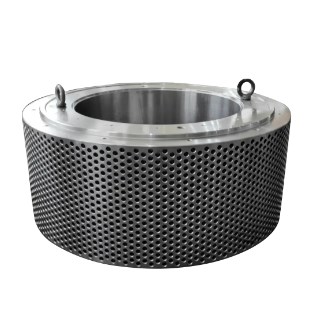-

+86-13404286222
-

hmjxboss@gmail.com

INQUIRE NOW

+86-13404286222

hmjxboss@gmail.com

INQUIRE NOW
Introduction to Jiangyin Huanming Machinery Co., Ltd.
2024-03-01The role of mechanical processing in the field of nuclear energy?
2024-03-18Introduction to the Application of Mechanical Processing in the Marine Industry?
2024-03-19How can mechanical processing improve the performance and reliability of wind turbines?
2024-03-26What are the applications of machining in the field of wind power metallurgy?
2024-03-27In modern mining beneficiation and grinding processes, high-pressure grinding rollers (HPGRs), as key equipment for high efficiency and energy conservation, are becoming a mainstream trend in the mineral pulverization process. The HPGR tire parts roller, as its core working component, undertakes the critical tasks of high-pressure extrusion and material crushing. Its performance directly determines the efficiency, stability, and lifespan of the entire machine. With the continuous advancement of materials science and manufacturing technology, the design concept, surface technology, and application performance of HPGR tire parts rollers are being continuously optimized, becoming a focus of attention in the mining equipment manufacturing sector.
I. Structure and Functional Features of HPGR Tire Parts Rollers
The core of the HPGR lies in two counter-rotating rollers, which crush materials under high pressure. The tire parts on the outer surface of the rollers are the most significant wear component in the entire system. The tire parts rollers are typically made of high-strength alloy steel or wear-resistant composite materials. Their surfaces are precision machined and reinforced to maintain excellent durability under the combined effects of high pressure, impact, and friction.
The outer structure of the drum typically features a replaceable tire design, facilitating maintenance and replacement, thereby extending the life of the entire machine and reducing operating costs. The core shaft of the drum features high toughness and strength to support the tire's stable operation under high pressure. HPGR tire drums must not only withstand the pressure of material compression but also resist inter-particle shear and rolling wear. Therefore, manufacturing precision and surface quality are key indicators of their performance.

II. Innovation Trends in Materials and Manufacturing Processes
The manufacturing technology of HPGR tire drums has been continuously evolving in recent years. Traditional monolithic casting structures have gradually been replaced by modular and high-performance composite structures. The use of new materials such as high-chromium cast iron, carbide inserts, and tungsten carbide spray coatings has significantly improved the wear and fatigue resistance of the drum. Furthermore, meticulously controlled heat treatment technology achieves an ideal balance between material hardness and toughness, ensuring that the drum will not crack or deform during long-term high-pressure operation.
Surface enhancement technology is also an important means of extending drum life. In recent years, laser cladding and high-energy spray welding technologies have become increasingly popular. By forming a dense, high-hardness protective layer on the drum surface, they effectively slow wear and improve overall impact resistance. The combination of these processes significantly extends the life of HPGR tire rollers compared to previous generations while maintaining high material pulverization efficiency.
III. Performance Advantages of HPGR Tire Rollers in Mineral Crushing
The most significant feature of HPGR technology is the laminated crushing effect under high pressure, which creates microcracks within the material, significantly reducing energy consumption in the subsequent grinding stage. The tire roller plays a crucial role in this process. Its surface morphology, friction coefficient, and pressure distribution directly influence the material's stress state and pulverization efficiency.
High-quality HPGR rollers possess excellent dimensional stability and surface flatness, enabling stable pressure distribution and efficient energy transfer. Furthermore, specific patterns or hard inserts on the roller surface can enhance the material's self-grinding action, reduce slippage, and improve pulverization efficiency. Consequently, even small differences in roller design and manufacturing can lead to significant changes in energy consumption, output, and particle size control.
IV. The Key Impact of Surface Design and Wear-Resistant Technology
During HPGR operation, the roller surface is in constant direct contact with the ore, resulting in complex wear patterns. The surface design of tire component rollers must balance wear resistance and friction stability. Common optimization approaches include using a segmented design to improve durability, optimizing geometry to reduce material slippage, and embedding hard material layers to enhance localized wear resistance.
Advanced surface engineering technologies significantly extend the roller's service life. For example, tungsten carbide or aluminum oxide coatings effectively resist wear from high-hardness ores. Multi-layer composite processes can create a gradient hardening layer on the roller surface, achieving a transition in performance from the surface layer to the base. These technologies not only reduce maintenance frequency but also improve overall equipment stability and continuous operation.

V. HPGR Tire Component Roller Maintenance and Life Management
During the long-term operation of high-pressure grinding rollers, roller maintenance strategies are crucial to production continuity. Thanks to their removable tire design, modern HPGR rollers facilitate regular inspection and replacement. Monitoring wear layer thickness, surface cracks, and temperature changes enables early warning and life prediction, thus avoiding unplanned downtime.
Additionally, optimizing the lubrication and cooling systems significantly impacts roller performance. Maintaining stable bearing and surface temperatures and reducing thermal expansion and deformation can extend the roller's service life. The introduction of modern intelligent monitoring systems has gradually shifted equipment maintenance from "periodic replacement" to "condition-based maintenance," enabling full lifecycle management of roller components.
As a core component of the high-pressure grinding roller, the performance of the HPGR tire roller determines the equipment's operating efficiency and economic benefits. From material selection to surface treatment, structural design to intelligent monitoring, the optimization of every step reflects the precision and innovation of modern industrial manufacturing. In the future, with the continued development of new materials, new processes, and intelligent manufacturing technologies, HPGR tire rollers will play an even more important role in energy conservation and efficient production in the global mining industry.
 No. 16 Dayuanli Road, Yunting Street, Jiangyin City, Jiangsu Province, China
No. 16 Dayuanli Road, Yunting Street, Jiangyin City, Jiangsu Province, China
 +86-13404286222 / +86-13404286222
+86-13404286222 / +86-13404286222
 +86-510-86668678
+86-510-86668678
 hmjxboss@gmail.com
hmjxboss@gmail.com
Copyright © Jiangyin Huanming Machinery Co., Ltd. All Rights Reserved.Custom Large Components Mechanical Processing Manufacturers
